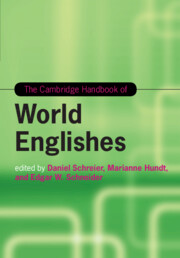Book contents
- The Cambridge Handbook of World Englishes
- Cambridge Handbooks in Language and Linguistics
- The Cambridge Handbook of World Englishes
- Copyright page
- Dedication
- Contents
- Figures
- Maps
- Tables
- Notes on Contributors
- 1 World Englishes: An Introduction
- Part I The Making of Englishes
- Part II World Englishes Old and New
- 7 A Sociolinguistic Ecology of Colonial Britain
- 8 English in North America
- 9 English in the Caribbean and the Central American Rim
- 10 English in Africa
- 11 English in South Asia
- 12 English in Southeast Asia
- 13 World Englishes Old and New: English in Australasia and the South Pacific
- Part III Linguistics and World Englishes
- Part IV Current Challenges
- Index
- References
9 - English in the Caribbean and the Central American Rim
from Part II - World Englishes Old and New
Published online by Cambridge University Press: 16 December 2019
- The Cambridge Handbook of World Englishes
- Cambridge Handbooks in Language and Linguistics
- The Cambridge Handbook of World Englishes
- Copyright page
- Dedication
- Contents
- Figures
- Maps
- Tables
- Notes on Contributors
- 1 World Englishes: An Introduction
- Part I The Making of Englishes
- Part II World Englishes Old and New
- 7 A Sociolinguistic Ecology of Colonial Britain
- 8 English in North America
- 9 English in the Caribbean and the Central American Rim
- 10 English in Africa
- 11 English in South Asia
- 12 English in Southeast Asia
- 13 World Englishes Old and New: English in Australasia and the South Pacific
- Part III Linguistics and World Englishes
- Part IV Current Challenges
- Index
- References
Summary
This chapter discusses “newer” (i.e. in the last 400 years or less) varieties of English spoken in the Caribbean, in particular the relationship between the Caribbean and Central American varieties on the western edge of the Caribbean. It also presents a short discussion of the influences that have shaped these varieties and various popular heuristics for imagining their emergence as well as a description of the geographical locations in the Caribbean where these varieties are spoken. The social contexts of their emergence are also discussed as well as a grammatical sketch pointing out similarities and differences and a discussion of several theoretical issues of relevance to the field.
Keywords
- Type
- Chapter
- Information
- The Cambridge Handbook of World Englishes , pp. 185 - 209Publisher: Cambridge University PressPrint publication year: 2020
References
- 1
- Cited by

